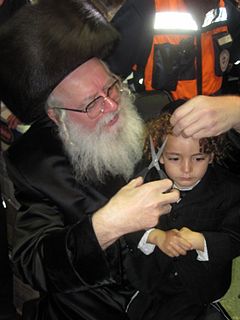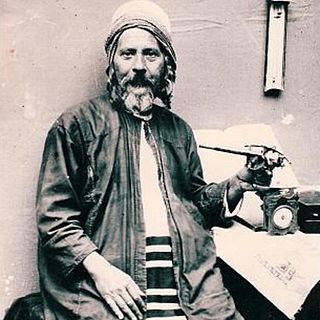
Aharon Kotler (1891–1962) was an Orthodox Jewish rabbi and a prominent leader of Orthodox Judaism in Lithuania, and later the United States, where he founded Beth Medrash Govoha in Lakewood Township, New Jersey.
Karaite Judaism or Karaism is a Jewish religious movement characterized by the recognition of the written Torah alone as its supreme authority in halakha and theology. Karaites maintain that all of the divine commandments handed down to Moses by God were recorded in the written Torah without additional Oral Law or explanation. Unlike mainstream Rabbinic Judaism, which considers the Oral Torah, codified in the Talmud and subsequent works, to be authoritative interpretations of the Torah, Karaite Jews do not consider the written collections of the oral tradition in the Midrash or Talmud as binding.

Upsherin, Upsheren, Opsherin or Upsherinish is a haircutting ceremony observed by a wide cross-section of Jews and is particularly popular in Haredi Jewish communities. It is typically held when a boy turns three years old. Among those who practice the upsherin, the male infant does not have his hair cut until this ceremony.

Strashelye was a branch of the Chabad school of Hasidic Judaism, named after the town Strashelye (Starasel'lye) in the Mohilev Province of present-day Belarus, where its leader lived. Like all Hasidism it is based on the teachings and customs of Chasidut as taught by the Baal Shem Tov, in turn based on the Kabbalistic works of Rabbi Isaac Luria.

Mezhbizh is the name of the town of Medzhybizh in the present Ukraine which is significant as both the source of a Hasidic dynasty that bears its name and as a symbolic name for the roots of Hasidism.
Shem Tov ben Abraham ibn Gaon was a Spanish Talmudist and kabbalist.

Yiḥyah Qafiḥ (1850–1931), known also by his term of endearment "Ha-Yashish", served as the Chief Rabbi of Sana'a, Yemen in the late nineteenth and early twentieth centuries. He was one of the foremost rabbinical scholars in Sana'a during that period, and one who advocated many reforms in Jewish education. Besides being learned in astronomy and in the metaphysical science of rabbinic astrology, as well as in Jewish classical literature which he taught to his young students.
Shem Mishmuel is a nine-volume collection of homiletical teachings on the Torah and Jewish holidays delivered by Rabbi Shmuel Bornsztain, the second Sochatchover Rebbe, between the years 1910-1926. A major work in Hasidic thought, it synthesizes the Hasidism of Pshischa and Kotzk in the style of Sochatchov, and is frequently cited in Torah shiurim (lectures) and articles to this day.
José Faur was a Sepharadi Hakham (rabbi), teacher and scholar. He was a Rabbi in the Syrian-Jewish community in Brooklyn for many years. He was also a professor at the Jewish Theological Seminary of America, the Spertus Institute for Jewish Learning and Leadership, and Bar Ilan University, and was Professor of Law at Netanya Academic College.
Yehuda Fetaya was a leading Kabbalist and authored many works of Kabbalah, among which three are well known, Yayin haReqa`h, Bet Le`hem Yehuda and Min`hat Yehuda.
The following charts illustrate the family of Rabbi Yisrael Baal Shem Tov, the founder of Hasidic Judaism.

Shaar Hashamayim Yeshiva is an Ashkenazi yeshiva in Jerusalem dedicated to the study of the kabbalistic teachings of the Arizal. It is famous for its student body of advanced kabbalists — many of them roshei yeshiva and Torah scholars — as well as beginning and intermediate scholars who study both the revealed and concealed Torah.

Rabbi Shimon Hakham was a Bukharan rabbi residing in Jerusalem who promoted literacy by translating Hebrew religious books into Bukhori.

Yochanan Sofer was the Rebbe of the Erlau dynasty, which though not the largest in the number of its adherents is still a significant movement within Haredi Judaism. He was born in Eger (German: Erlau), Hungary, where his father and grandfather served as Grand Rabbis. After surviving the Holocaust, he continued their legacy by founding a yeshiva and a movement in their name, first in Hungary and then a few years later in Jerusalem.
Erlau, is a Haredi dynasty of Hungarian origin, which follows the teachings of the Chasam Sofer and is often considered Hasidic.
In Jewish law, a Posek is a legal scholar who determines the position of halakha, the Jewish religious laws derived from the written and Oral Torah in cases of Jewish law where previous authorities are inconclusive, or in those situations where no clear halakhic precedent exists.

Nikolsburg is the name of a Hasidic dynasty descending from R. Samuek Shmelke Horowitz (1726–1778), who held a rabbinic post in Nikolsburg, Margraviate of Moravia, from where the dynasty gets in name. R. Shmelke was a disciple of R. Dov Ber of Mezeritch, the primary disciple of the Baal Shem Tov, the founder of Hasidism.

David ben Shimon, also known as Tzuf Devash and the Radvash was a rabbi who headed the North African Jewish community of Jerusalem in the Old Yishuv and established the neighbourhood Mahane Israel.
Yaakov de Castro, alternative spelling: Yaakov Costaro (1525–1610), was a rabbinic scholar, judge and exponent of Jewish law in Cairo, Egypt. A descendant of Jews who fled Portugal during the time of the Portuguese Inquisition, his family eventually came to settle in Egypt. A student of the illustrious Radbaz, he is considered the last Chief Rabbi of Egypt to hold sway over the entire Jewish community in Egypt, mostly Musta'arabi Jews, after the abolition of the office of nagid, and whose halachic rulings were widespread across the land. He was a nephew of the master of the mint for the Ottoman Sultan in Cairo, Abraham de Castro.

Shimon Lavi was a Sephardi Hakham, kabbalist, physician, astronomer, and poet. He is credited with the founding of religious institutions and the revival of Torah study in Tripoli, Libya, in the mid-sixteenth century, where he served as spiritual leader and dayan for more than three decades. He authored a commentary on the Zohar titled Ketem Paz and the piyyut, "Bar Yochai", a kabbalistic hymn which became widely popular in the Jewish world. Libyan Jews consider him their greatest scholar.











